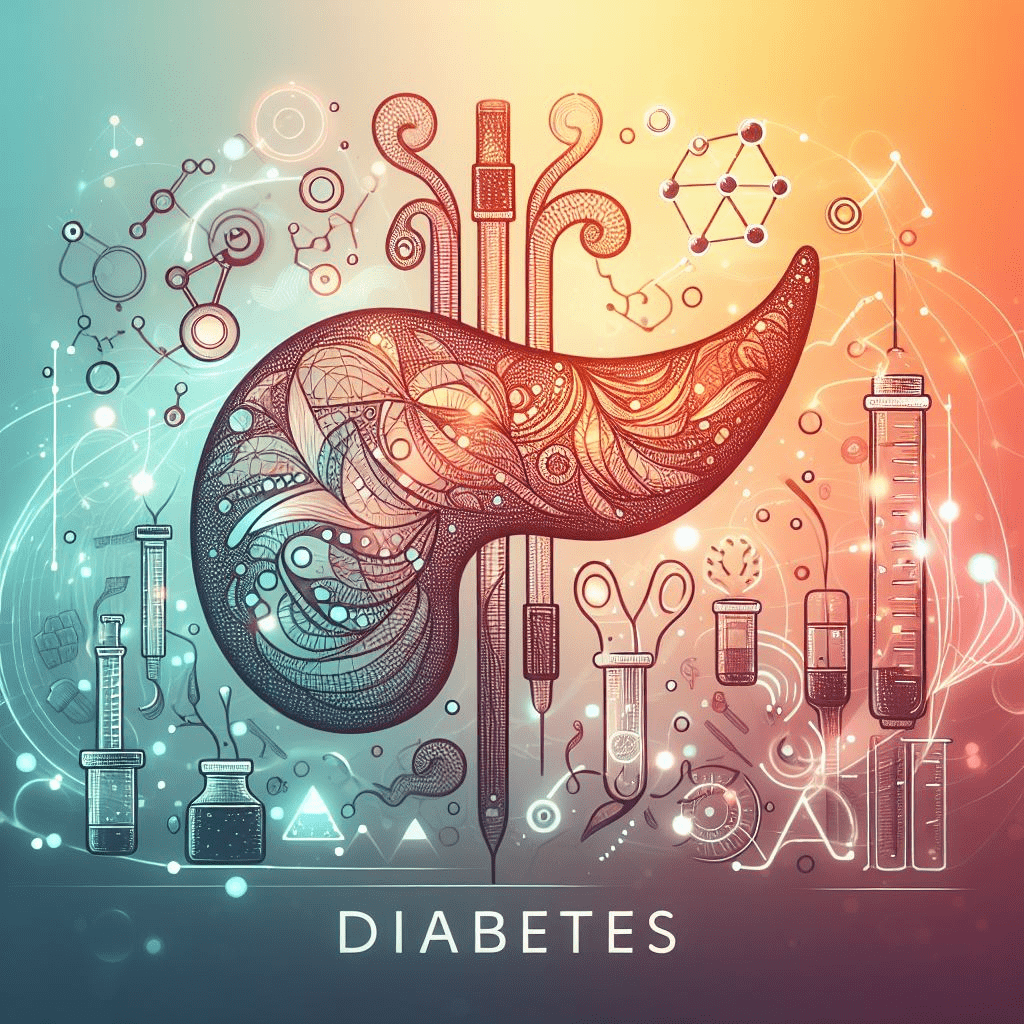The Basic Biology of Diabetes
–
Type 1 Diabetes
Type 1 diabetes is a chronic condition characterised by the autoimmune destruction of the insulin-producing β-cells within the islets of Langerhans in the pancreas.
Insulin Production and Destruction
- In normal circumstances, insulin is synthesised by the β-cells in response to glucose levels
- However, in Type 1 diabetes, these very β-cells become targets of the immune system
- Mistakenly identified as foreign, they face an autoimmune attack, leading to their destruction
- Consequently, an absolute deficiency of insulin occurs, necessitating lifelong reliance on external insulin sources
Genetic and Environmental Factors
- The onset of Type 1 diabetes involves a complex combination of genetic and environmental factors
- Genetic predisposition plays a significant role, with a strong association to specific HLA haplotypes and immune system genes
- Additionally, an infective or environmental trigger (such as a viral infection) may initiate the autoimmune response in genetically susceptible individuals
Immunological Damage
- The development of Type 1 diabetes is gradual and characterised by progressive immunological damage
- Insulitis occurs—an invasion of pancreatic islets by T-lymphocytes which ultimately leads to β-cell destruction
- Over time, this process results in insulin deficiency
Clinical Diagnosis
- Clinically, Type 1 diabetes is often diagnosed based on specific criteria:
- Capillary blood glucose levels greater than 11 mmol/L
- A history of classic osmotic symptoms (polyuria and polydipsia)
- Weight loss
- Assessment for the presence of ketones in the blood or urine
Long-Term Implications
- Insulin administration is crucial for maintaining blood glucose control
- Optimising overall glycaemic control helps prevent micro and macrovascular complications
- Elevated blood glucose levels in Type 1 diabetes can lead to premature morbidity and mortality
✾ β-cells: These are special cells in the pancreas that produce insulin, a hormone necessary for regulating blood sugar levels.
✾ Autoimmune: When the immune system mistakenly attacks healthy cells in the body, thinking they are harmful invaders.
✾ HLA haplotypes: These are specific genetic markers related to the immune system. They play a role in determining susceptibility to certain diseases.
✾ Insulitis: Refers to inflammation of the insulin-producing cells (β-cells) in the pancreas.
✾ Micro and macrovascular complications: These are health issues related to small blood vessels (microvascular) and large blood vessels (macrovascular). In diabetes, these complications can affect organs like the eyes, kidneys, and heart.
Type 2 Diabetes
Type 2 diabetes is a metabolic disorder where the body either becomes resistant to the effects of insulin or the pancreas cannot produce enough of it.
Insulin Resistance
Insulin resistance is when the cells in the body do not respond well to insulin.
Even though there is enough insulin in the blood, the cells do not take in enough sugar, leaving too much of that sugar in the blood.
This can happen because of several factors, such as:
- Changes in the cell membrane, which affect the transport of sugar and insulin across the membrane
- Alterations in the insulin receptor, which reduce the binding and signalling of insulin to the cell
- Dysregulation of the intracellular pathways, which impair the glucose uptake and metabolism by the cell
- Production of inflammatory cytokines, which interfere with the insulin action and induce insulin resistance
The gut microbiota, which is the collection of microorganisms that live in the digestive tract, can also influence the insulin resistance by affecting the inflammation, immunity and metabolism of the host.
Increased Glucose Production
Increased glucose production is when the liver makes too much sugar, even when the blood sugar levels are already high.
This adds more sugar to the blood and makes it harder to control.
This can happen because of several factors, such as:
- Activation of the gluconeogenesis, which is the process of making new sugar from non-carbohydrate sources, such as amino acids, lactate or glycerol
- Suppression of the glycogenolysis, which is the process of breaking down the stored sugar (glycogen) in the liver and releasing it into the blood
- Stimulation of the glucagon, which is a hormone that increases the blood sugar levels by activating the gluconeogenesis and glycogenolysis
- Inhibition of the insulin, which is a hormone that lowers the blood sugar levels by suppressing the gluconeogenesis and glycogenolysis.
The gut microbiota can also affect the glucose production by producing different metabolites, such as short-chain fatty acids (SCFAs), bile acids, and amino acids.
These can influence the glucose metabolism and the secretion of hormones, such as insulin and glucagon-like peptide-1 (GLP-1) that regulate the blood glucose levels.
Beta-Cell Dysfunction
Beta-cell dysfunction is when the cells in the pancreas that make insulin become damaged and stop working overtime.
This leads to less insulin in the blood and more sugar in the blood.
This can happen because of several factors:
- Exposure to high levels of sugar, which can cause oxidative stress and inflammation in the beta cells, leading to their death or dysfunction
- Exposure to high levels of fatty acids, which can cause lipotoxicity and apoptosis in the beta cells, leading to their death or dysfunction.
- Exposure to high levels of inflammatory cytokines, which can cause immune-mediated damage and dysfunction in the beta cells, leading to their death or dysfunction.
- Exposure to high levels of amyloid, which is a protein that can accumulate and form toxic aggregates in the beta cells, leading to their death or dysfunction.
The gut microbiota can also affect the beta-cell function by modulating the immune and inflammatory responses, and by producing certain metabolites, such as SCFAs, that can protect or enhance the beta-cell survival and function.
Inflammation and Fat Accumulation
Inflammation and fat accumulation are when the body has too much fat, especially around the belly, which can cause inflammation and release certain proteins that interfere with insulin action.
This makes the cells more resistant to insulin, and can happen because of several factors:
- Excess intake of calories, which can lead to weight gain and obesity, which are major risk factors for type 2 diabetes
- Imbalance in the adipokines, which are proteins that are produced by the fat cells and that can affect the insulin sensitivity and glucose metabolism of the body
- Accumulation of ectopic fat, which is fat that is stored in or around the organs, such as the liver and the pancreas, and that can impair their function and induce insulin resistance
- Activation of the innate immune system, which can trigger the production of inflammatory cytokines and reactive oxygen species, which can damage the cells and tissues and induce insulin resistance
The gut microbiota can also influence the inflammation and fat accumulation by affecting the energy balance, the fat storage, the adipokine secretion and the immune activation of the host.
✾ Inflammatory Cytokines: Proteins that are secreted by immune cells and other cell types to promote inflammation, which is a protective response to infection or injury.
✾ Gut Microbiota: The collection of microorganisms that live in the digestive tract
✾ Gluconeogenesis: The process of making new sugar from non-carbohydrate sources, such as amino acids, lactate or glycerol
✾ Glycogenolysis: The process of breaking down the stored sugar (glycogen) in the liver and releasing it into the blood
✾ Short Chain Fatty Acids (SCFAs): Fatty acids with fewer than six carbon atoms. They are produced by the bacteria in the gut when they ferment fibre. SCFAs are important for colon health as they provide energy to the cells lining the colon. SCFAs also have various benefits for metabolism, inflammation, immune system and blood sugar control.
✾ Lipotoxicity: A metabolic syndrome that occurs when excess lipids, such as fatty acids, accumulate in non-adipose tissues, such as the liver, heart or pancreas leading to cellular dysfunction and even cell death
✾ Adipokines: Proteins that are produced by the fat cells and that can affect the insulin sensitivity and glucose metabolism of the body

Gestational Diabetes
Gestational diabetes mellitus (GDM) is a condition that affects some pregnant women, who develop high blood sugar levels due to impaired glucose metabolism.
It is one of the most common complications of pregnancy, and its prevalence is increasing worldwide.
GDM is the result of two major metabolic disorders that occur during pregnancy:
Chronic Insulin Resistance
This is when the cells of the body become less responsive to insulin, the hormone that regulates glucose uptake from the bloodstream.
This leads to hyperglycaemia, or elevated blood glucose levels.
Insulin resistance is a normal physiological adaptation of pregnancy, as it allows more glucose to be available for the growing foetus.
However, in some women, the insulin resistance becomes too severe and exceeds the compensatory increase in insulin secretion by the pancreas.
β-cell Dysfunction
This is when the β-cells of the pancreas, which produce and secrete insulin, fail to function properly.
This impairs the ability of the pancreas to produce enough insulin to overcome the insulin resistance.
β-cell dysfunction is a key factor in the development of both GDM and Type 2 diabetes mellitus (T2DM).
Several risk factors, such as advanced maternal age, overweight, obesity, westernised diet, ethnicity, intrauterine environment, hypertension, family history of GDM or T2DM, and personal history of GDM or polycystic ovarian syndrome, can affect the β-cell function and/or insulin sensitivity, either directly or indirectly.
Therefore, GDM can be seen as a transient manifestation of underlying metabolic abnormalities that may predispose women to develop T2DM later in life.
(In short, GDM is basically a sneak peek of what could happen to your metabolism later in life).
✾ Gestational Diabetes Mellitus is influenced by both genetic and environmental factors, and it can have short-term and long-term consequences for both the mother and the offspring.

You won’t be expected to know everything immediately, so start with the basic biology, particularly the endocrine system, as it is crucial for understanding diabetes.
Steroid Induced Diabetes
Steroid-induced diabetes is caused by two main problems in your metabolism.
Steroids make your muscle and fat cells resist insulin, which means they don’t take up glucose from your blood.
It makes your liver resist insulin, which means it keeps making more glucose (gluconeogenesis and glycogenolysis) even when you don’t need it.
Steroids also make your pancreas produce and release less insulin, which means you can’t lower your blood sugar level.
Glucocorticoid Receptor (GR) Activation
Steroids, especially the ones called glucocorticoids, stick to special proteins called glucocorticoid receptors (GRs) in different parts of your body, like your liver, muscle, and fat tissue.
When GRs are activated by steroids, they change the way your genes work, affecting how your body handles sugar.
In your liver, GR activation makes your genes produce more enzymes that make glucose from scratch (gluconeogenesis).
In your muscle and fat tissue, GR activation makes your genes produce less proteins that help your cells take up glucose from your blood (such as GLUT4).
Insulin Resistance
Steroids make your body ignore insulin, the hormone that tells your cells to take up sugar from your blood.
GR activation stops a molecule called insulin receptor substrate-1 (IRS-1) from working properly, breaking the chain of signals that insulin sends to your cells.
When IRS-1 doesn’t work, your cells can’t take up glucose or store it as glycogen (a form of sugar storage).
Hepatic Gluconeogenesis and Glycogenolysis
Steroids make your liver produce more glucose.
GR activation makes your genes produce more enzymes that make glucose from scratch (gluconeogenesis) or from glycogen (glycogenolysis).
Glycogenolysis is when your liver breaks down glycogen, the stored form of sugar, into glucose.
Beta-Cell Dysfunction
Steroids make your pancreas produce and release less insulin.
GR activation makes your genes produce less insulin and release less insulin.
Your pancreas cells may die (apoptosis) if you take steroids for too long.
Adipokines and Inflammation
Steroids change the way your fat tissue releases hormones called adipokines.
Some adipokines are bad for you, like TNF-alpha and IL-6, because they cause inflammation and make your body resist insulin.
Your fat tissue may also get inflamed, which makes your blood sugar level worse.
Alterations in Gut Microbiota
There is some evidence that steroids may affect the bacteria in your gut (gut microbiota).
Having a balanced gut microbiota is important for your health, but steroids may cause an imbalance (dysbiosis).
A dysbiotic gut microbiota may make your body resist insulin and cause inflammation.
Individual Variability
✾ Not everyone who takes steroids gets steroid-induced diabetes.
✾ Your genes, how long you take steroids, your overall health, and other factors can affect your risk of getting steroid-induced diabetes.
So there you have it.
The biology of Type 1, Type 2, gestational and Steroid induced diabetes.
Going through your biology will always bring you one step closer to understanding what is going on and why, allowing you to provide the most effective care.

Question Time
Read the questions and if you have the answers, flaunt your knowledge and share your thoughts and experiences in the comment section below.

How would you explain the concept of insulin resistance to someone learning about diabetes for the first time?
If you could invent a new treatment for diabetes based on its biology, what would it be?
What is one aspect of diabetes biology that you find most intriguing and why?















